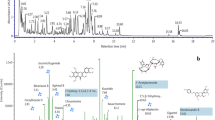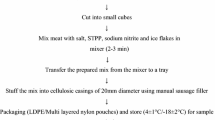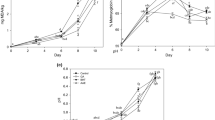Abstract
The antioxidant competence of aloe vera, green tea, and amla extracts were estimated and compared with existing synthetic antioxidant like butylated hydroxytoluene (BHT). The antimicrobial and antioxidative effectiveness of these extracts in raw meat batter during 12 days refrigerated (4 ± 1 °C) storage was evaluated. Total antioxidant activities, radical scavenging activities and reducing powers of green tea and amla extracts were as good as tannic acid, ascorbic acid and BHT which might be due to presence of higher phenolic and flavonoid contents in these extracts. Amla showed significantly (P < 0.05) higher antimicrobial activity followed by green tea. Aloe treatment resulted in lesser microbial inhibition in raw meat batter. Inhibition by thiobarbituric acid-reactive substances and free fatty acids was observed more in treated sample during storage (4 ± 1 °C) and this inhibition was comparable to positive control samples. In conclusion, green tea and amla extract showed good antimicrobial and antioxidative effect in raw meat batter without compromising other properties.

Similar content being viewed by others
Abbreviations
- AAE:
-
Ascorbic acid equivalent
- Am:
-
Amla
- AV:
-
Aloe vera
- BHT:
-
Butylated hydroxytoluene
- CE:
-
Catechin equivalent
- DPPH:
-
2, 2-diphenyl-1-picrylhydrazyl or 1, 1-diphenyl-2-picrylhydrazyl radical
- EGC:
-
Epigallocatechin
- EGCG:
-
Epigallocatechin gallate
- F–C:
-
Folin–Ciocalteus
- FFA:
-
Free fatty acids
- gdw:
-
Gram dry weight
- GT:
-
Green tea
- LDPE:
-
Low-density polyethylene
- SA:
-
Scavenging activity
- TF:
-
Total flavonoids
- TAA:
-
Total antioxidant activities
- TAE:
-
Tannic acid equivalent
- TBA:
-
2-Thiobarbituric acid
- TBARS:
-
Thiobarbituric acid-reactive substances
- TP:
-
Total phenolics
- WHC:
-
Water-holding capacity
References
Aguirrezábal MM, Mateo J, Domínguez MC, Zumalacárregui JM (2000) The effect of paprika, garlic and salt on rancidity in dry sausages. Meat Sci 54(1):77–81
Almajano MP, Carbó R, Jiménez JAL, Gordon MH (2008) Antioxidant and antimicrobial activities of tea infusions. Food Chem 108(1):55–63
APHA (1984) Recommended methods for microbiological examination of foods. American Public Health Association, New York
Brand-Williams W, Cuvelier ME, Berset C (1995) Use of a free radical method to evaluate antioxidant activity. LWT Food Sci Technol 28(1):25–30
Camo J, Beltrán JA, Roncalés P (2008) Extension of the display life of lamb with an antioxidant active packaging. Meat Sci 80(4):1086–1091
Chen X, Jo C, Lee JI, Ahn DU (1999) Lipid oxidation, volatiles and color changes of irradiated pork patties affected by antioxidants. J Food Sci 64(1):16–19
Duh P-D, Tu Y-Y, Yen G-C (1999) Antioxidant activity of water extract of harng jyur (Chrysanthemum morifolium ramat). LWT Food Sci Technol 32(5):269–277
Escarpa A, González MC (2001) Approach to the content of total extractable phenolic compounds from different food samples by comparison of chromatographic and spectrophotometric methods. Anal Chim Acta 427(1):119–127
Fasseas MK, Mountzouris KC, Tarantilis PA, Polissiou M, Zervas G (2008) Antioxidant activity in meat treated with oregano and sage essential oils. Food Chem 106(3):1188–1194
Ferro VA, Bradbury F, Cameron P, Shakir E, Rahman SR, Stimson WH (2003) In vitro susceptibilities of Shigella flexneri and Streptococcus pyogenes to inner gel of Aloe barbadensis miller. Antimicrob Agents Chemother 47(3):1137–1139
Gramza A, Korczak J (2005) Tea constituents (Camellia sinensis L.) as antioxidants in lipid systems. Trends Food Sci Technol 16(8):351–358
Hamilton-Miller JMT, Shah S (1999) Disorganization of cell division of methicillin-resistant Staphylococcus aureus by a component of tea (Camellia sinensis): a study by electron microscopy. FEMS Microbiol Lett 176(2):463–469
Jayaprakasha GK, Singh RP, Sakariah KK (2001) Antioxidant activity of grape seed (Vitis vinifera) extracts on peroxidation models in vitro. Food Chem 73(3):285–290
Koniecko EK (1979) Handbook for meat chemists. Avery Publishing Group Inc., Wyne
Kumar GS, Nayaka H, Dharmesh SM, Salimath PV (2006) Free and bound phenolic antioxidants in amla (Emblica officinalis) and turmeric (Curcuma longa). J Food Compost Anal 19(5):446–452
Kumudavally KV, Phanindrakumar HS, Tabassum A, Radhakrishna K, Bawa AS (2008) Green tea—a potential preservative for extending the shelf life of fresh mutton at ambient temperature (25 ± 2 °C). Food Chem 107(1):426–433
Lee EJ, Ahn DU (2003) Effect of antioxidants on the production of off-odor volatiles and lipid oxidation in irradiated turkey breast meat and meat homogenates. J Food Sci 68(5):1631–1638
Mallavadhani UV, Sudhakar AVS, Satyanarayana KVS, Mahapatra A, Li W, vanBreemen RB (2006) Chemical and analytical screening of some edible mushrooms. Food Chem 95(1):58–64
Mayachiew P, Devahastin S (2008) Antimicrobial and antioxidant activities of Indian gooseberry and galangal extracts. LWT Food Sci Technol 41(7):1153–1159
Nagendra Prasad K, Yang B, Yang S, Chen Y, Zhao M, Ashraf M, Jiang Y (2009) Identification of phenolic compounds and appraisal of antioxidant and antityrosinase activities from litchi (Litchi sinensis Sonn.) seeds. Food Chem 116(1):1–7
Prieto P, Pineda M, Aguilar M (1999) Spectrophotometric quantitation of antioxidant capacity through the formation of a phosphomolybdenum complex: specific application to the determination of vitamin E. Anal Biochem 269(2):337–341
Reynolds T, Dweck AC (1999) Aloe vera leaf gel: a review update. J Ethnopharmacol 68(1–3):3–37
Shan B, Cai Y-Z, Brooks JD, Corke H (2007) Antibacterial properties and major bioactive components of cinnamon stick (Cinnamomum burmannii): activity against foodborne pathogenic bacteria. J Agric Food Chem 55(14):5484–5490
Shan B, Cai YZ, Sun M, Corke H (2005) Antioxidant capacity of 26 spice extracts and characterization of their phenolic constituents. J Agric Food Chem 53(20):7749–7759
Shen Z, Chauser-Volfson E, Hu Z, Gutterman Y (2001) Leaf age, position and anatomical influences on the distribution of the secondary metabolites, homonataloin and three isomers of aloeresin in Aloe hereroensis (Aloaceae) leaves, vol 2. Foundation for Education, Science and Technology, Pretoria
Si W, Gong J, Tsao R, Kalab M, Yang R, Yin Y (2006) Bioassay-guided purification and identification of antimicrobial components in Chinese green tea extract. J Chromatogr A 1125(2):204–210
Siddhuraju P, Becker K (2003) Antioxidant properties of various solvent extracts of total phenolic constituents from three different agroclimatic origins of drumstick tree (Moringa oleifera lam.) leaves. J Agric Food Chem 51(8):2144–2155
Singh RP, Chidambara Murthy KN, Jayaprakasha GK (2002) Studies on the antioxidant activity of pomegranate (Punica granatum) peel and seed extracts using in vitro models. J Agric Food Chem 50(1):81–86
Wardlaw FB, McCaskill LH, Acton JC (1973) Effect of postmortem muscle changes on poultry meat loaf properties. J Food Sci 38(3):421–423
Witte VC, Krause GF, Bailey ME (1970) A new extraction method for determining 2-thiobarbituric acid values of pork and beef during storage. J Food Sci 35(5):582–585
Wojdyło A, Oszmiański J, Czemerys R (2007) Antioxidant activity and phenolic compounds in 32 selected herbs. Food Chem 105(3):940–949
Wu S-C, Yen G-C, Wang B-S, Chiu C-K, Yen W-J, Chang L-W, Duh P-D (2007) Antimutagenic and antimicrobial activities of pu-erh tea. LWT Food Sci Technol 40(3):506–512
M-c Yin, W-s Cheng (2003) Antioxidant and antimicrobial effects of four garlic-derived organosulfur compounds in ground beef. Meat Sci 63(1):23–28
Zhishen J, Mengcheng T, Jianming W (1999) The determination of flavonoid contents in mulberry and their scavenging effects on superoxide radicals. Food Chem 64(4):555–559
Author information
Authors and Affiliations
Corresponding author
Rights and permissions
About this article
Cite this article
Kumar, Y., Langoo, B.A. Effects of Aloe, Green Tea, and Amla Extracts on Microbiological and Oxidative Parameters of Refrigerated Raw Meat Batter. Agric Res 5, 81–88 (2016). https://doi.org/10.1007/s40003-015-0182-6
Received:
Accepted:
Published:
Issue Date:
DOI: https://doi.org/10.1007/s40003-015-0182-6




